Voltage Support Experimental Analysis of a Low-Voltage Ride-Through Strategy Applied to Grid-Connected Distributed Inverters
Abstract
1. Introduction
- To extend, in a scenario of multiple grid-connected inverters, the use or application of LVRT control strategy [25], whose voltage support capability has not been tested when voltage sags occur.
- To carry out an analysis of the experimental results of the power injection profiles (PIPs) as a function of the generated power (PG) and the equivalent impedance seen from the output side of each converter.
2. Multiple Grid-Connected Inverters under Voltage Sags
2.1. Experimental Network Configuration
2.2. Voltage Sag Characterization
2.3. Requirements under Voltage Sags
3. Problem Statement
3.1. Voltage Support Concept
3.2. Comparison of the Principal Strategies for Generating Reference Currents in Grid-Connected Inverters
3.3. Problem Formulation
- Capability to deliver both P and Q into the grid.
- Current injection by positive and negative sequences (Ip+, Iq+, Ip− and Iq−).
- Low THD.
- Maximum current limitation.
- Mitigation of active power oscillations.
- Reduced complexity (control algorithm with a set of reduced instructions).
3.4. Control Scheme
- To prioritize injection of active power.
- To inject the rated current.
- To apply APC when PG > Pmax.
- To inject reactive power into the grid when PG < Pmax to reach Irated.
- To avoid active power oscillations (p̃ = 0).
4. Experimental Results
4.1. Operation of Multiple Grid-Connected Inverters
4.2. Experimental Analysis of the Voltage Support Capability
4.2.1. Power Injection Profile 1
4.2.2. Power Injection Profile 2
4.2.3. Power Injection Profile 3
4.2.4. Power Injection Profile 4
4.2.5. Power Injection Profile 5
4.3. Discussion on Voltage Support Capabilities
4.4. Future Works
5. Conclusions
Author Contributions
Funding
Conflicts of Interest
References
- Katti, P.K.; Khedkar, M.K. Integrated operation of decentralised resources for rural area power supply applications. In Proceedings of the 2005 IEEE/PES Transmission & Distribution Conference & Exposition: Asia and Pacific, Dalian, China, 18 August 2005. [Google Scholar]
- Blaabjerg, F.; Teodorescu, R.; Liserre, M.; Timbus, A.V. Overview of Control and Grid Synchronization for Distributed Power Generation Systems. IEEE Trans. Ind. Electron. 2006, 53, 1398–1409. [Google Scholar] [CrossRef]
- Troester, E. New German Grid Codes for Connecting PV Systems to the Medium Voltage Power Grid. Available online: https://scholar.google.es/scholar?cluster=5874071522966012685&hl=es&as_sdt=0,5&as_vis=1 (accessed on 25 July 2018).
- Tsili, M.; Papathanassiou, S. A review of grid code technical requirements for wind farms. IET Renew. Power Gener. 2009, 3, 308–332. [Google Scholar] [CrossRef]
- Altin, M.; Goksu, O.; Teodorescu, R.; Rodriguez, P.; Jensen, B.-B.; Helle, L. Overview of recent grid codes for wind power integration. In Proceedings of the 2010 12th International Conference on Optimization of Electrical and Electronic Equipment, Basov, Romania, 20–22 May 2010; pp. 1152–1160. [Google Scholar]
- Yang, Y.; Enjeti, P.; Blaabjerg, F.; Wang, H. Wide-Scale Adoption of Photovoltaic Energy: Grid Code Modifications Are Explored in the Distribution Grid. IEEE Ind. Appl. Mag. 2015, 21, 21–31. [Google Scholar] [CrossRef]
- Waveform Characteristics of Voltage Sags: Statistical Analysis; TR-112692; EPRI: Palo Alto, CA, USA, 1999.
- Smith, J.C.; Hensley, G.; Ray, L. IEEE Recommended Practice for Monitoring Electric Power Quality; IEEE Standards Association: Piscataway, NJ, USA, 1995. [Google Scholar]
- Teodorescu, R.; Liserre, M.; Rodríguez, P. Grid Requirements for PV. In Grid Converters for Photovoltaic and Wind Power Systems; John Wiley & Sons, Ltd.: Chichester, UK, 2010; pp. 31–42. [Google Scholar]
- Teodorescu, R.; Liserre, M.; Rodríguez, P. Grid Requirements for WT Systems. In Grid Converters for Photovoltaic and Wind Power Systems; John Wiley & Sons, Ltd.: Chichester, UK, 2010; pp. 145–167. [Google Scholar]
- Sourkounis, C.; Tourou, P. Grid Code Requirements for Wind Power Integration in Europe. Conf. Pap. Energy 2013, 2013, 437674. [Google Scholar] [CrossRef]
- Uphues, A.; Notzold, K.; Griessel, R.; Wegener, R.; Soter, S. Overview of LVRT-capability pre-evaluation with an inverter based test bench. In Proceedings of the 2015 IEEE 24th International Symposium on Industrial Electronics (ISIE), Buzios, Brazil, 3–5 June 2015. [Google Scholar]
- Teodorescu, R.; Liserre, M.; Rodríguez, P. Islanding Detection. In Grid Converters for Photovoltaic and Wind Power Systems; John Wiley & Sons, Ltd.: Chichester, UK, 2010; pp. 93–122. [Google Scholar]
- Alepuz, S.; Busquets-Monge, S.; Bordonau, J.; Martinez-Velasco, J.A.; Silva, C.A.; Pontt, J.; Rodriguez, J. Control Strategies Based on Symmetrical Components for Grid-Connected Converters Under Voltage Dips. IEEE Trans. Ind. Electron. 2009, 56, 2162–2173. [Google Scholar] [CrossRef]
- Wang, F.; Duarte, J.L.; Hendrix, M.A. Pliant Active and Reactive Power Control for Grid-Interactive Converters Under Unbalanced Voltage Dips. IEEE Trans. Power Electron. 2011, 26, 1511–1521. [Google Scholar] [CrossRef]
- Camacho, A.; Castilla, M.; Miret, J.; Vasquez, J.C.; Alarcón-Gallo, E. Flexible Voltage Support Control for Three-Phase Distributed Generation Inverters Under Grid Fault. IEEE Trans. Ind. Electron. 2013, 60, 1429–1441. [Google Scholar] [CrossRef]
- Miret, J.; Camacho, A.; Castilla, M.; García de Vicuña, J.L.; Matas, J. Control Scheme With Voltage Support Capability for Distributed Generation Inverters Under Voltage Sags. IEEE Trans. Power Electron. 2013, 28, 5252–5262. [Google Scholar] [CrossRef]
- Camacho, A.; Castilla, M.; Miret, J.; Guzman, R.; Borrell, A. Reactive Power Control for Distributed Generation Power Plants to Comply With Voltage Limits During Grid Faults. IEEE Trans. Power Electron. 2014, 29, 6224–6234. [Google Scholar] [CrossRef]
- Miret, J.; Castilla, M.; Camacho, A.; García de Vicuña, J.L.; Matas, J. Control Scheme for Photovoltaic Three-Phase Inverters to Minimize Peak Currents During Unbalanced Grid-Voltage Sags. IEEE Trans. Power Electron. 2012, 27, 4262–4271. [Google Scholar] [CrossRef]
- Rodriguez, P.; Luna, A.; Hermoso, J.R.; Etxeberria-Otadui, I.; Teodorescu, R.; Blaabjerg, F. Current control method for distributed generation power generation plants under grid fault conditions. In Proceedings of the IECON 2011—37th Annual Conference of the IEEE Industrial Electronics Society, Melbourne, VIC, Australia, 7–10 November 2011; pp. 1262–1269. [Google Scholar]
- Rodriguez, P.; Medeiros, G.; Luna, A.; Cavalcanti, M.C.; Teodorescu, R. Safe current injection strategies for a STATCOM under asymmetrical grid faults. In Proceedings of the 2010 IEEE Energy Conversion Congress and Exposition, Atlanta, GA, USA, 12–16 Sepember 2010; pp. 3929–3935. [Google Scholar]
- Suul, J.A.; Luna, A.; Rodriguez, P.; Undeland, T. Virtual-Flux-Based Voltage-Sensor-Less Power Control for Unbalanced Grid Conditions. IEEE Trans. Power Electron. 2012, 27, 4071–4087. [Google Scholar] [CrossRef]
- Lee, C.-T.; Hsu, C.-W.; Cheng, P.-T. A Low-Voltage Ride-Through Technique for Grid-Connected Converters of Distributed Energy Resources. IEEE Trans. Ind. Appl. 2011, 47, 1821–1832. [Google Scholar] [CrossRef]
- Camacho, A.; Castilla, M.; Miret, J.; Borrell, A.; García de Vicuna, J.L. Active and Reactive Power Strategies With Peak Current Limitation for Distributed Generation Inverters During Unbalanced Grid Faults. IEEE Trans. Ind. Electron. 2015, 62, 1515–1525. [Google Scholar] [CrossRef]
- Sosa, J.L.; Castilla, M.; Miret, J.; Matas, J.; Al-Turki, Y.A. Control Strategy to Maximize the Power Capability of PV Three-Phase Inverters During Voltage Sags. IEEE Trans. Power Electron. 2016, 31, 3314–3323. [Google Scholar] [CrossRef]
- Tang, C.; Chen, Y.-T.; Chen, Y. PV Power System With Multi-Mode Operation and Low-Voltage Ride-Through Capability. IEEE Trans. Ind. Electron. 2015, 62, 7524–7533. [Google Scholar] [CrossRef]
- Chen, H.-C.; Lee, C.-T.; Cheng, P.-T.; Teodorescu, R.; Blaabjerg, F. A Low-Voltage Ride-Through Technique for Grid-connected Converters with Reduced Power Transistors Stress. IEEE Trans. Power Electron. 2016, 31, 8562–8571. [Google Scholar] [CrossRef]
- Mozumder, S.; Dhar, A.; Rangarajan, S.S.; Karthikeyan, S.P. Coordinated operation of multiple inverter based renewable distributed generators as an active power injector and reactive power compensator. In Proceedings of the 2014 International Conference on Computation of Power, Energy, Information and Communication (ICCPEIC), Chennai, India, 16–17 April 2014; pp. 298–303. [Google Scholar]
- Lee, Y.-D.; Park, S.-Y. Reactive power allocation control scheme for multiple grid connected inverters. In Proceedings of the 2015 9th International Conference on Power Electronics and ECCE Asia (ICPE-ECCE Asia), Seoul, Korea, 1–5 June 2015; pp. 2481–2488. [Google Scholar]
- Velasco, M.; Martí, P.; Torres-Martínez, J.; Miret, J.; Castilla, M. On the optimal reactive power control for grid-connected photovoltaic distributed generation systems. In Proceedings of the IECON 2015—41st Annual Conference of the IEEE Industrial Electronics Society, Yokohama, Japan, 9–12 November 2015. [Google Scholar]
- Momeneh, A.; Castilla, M.; Miret, J.; Martí, P.; Velasco, M. Comparative study of reactive power control methods for photovoltaic inverters in low-voltage grids. IET Renew. Power Gener. 2016, 10, 310–318. [Google Scholar] [CrossRef]
- Martí, P.; Velasco, M.; Torres-Martínez, J.; Miret, J.; Castilla, M. Reactive power control for loss minimization in low-voltage distributed generation systems. In Proceedings of the 2016 12th IEEE International Conference on Control and Automation (ICCA), Kathmandu, Nepal, 1–3 June 2016; pp. 371–376. [Google Scholar]
- Kulkarni, O.V.; Doolla, S.; Fernandes, B.G. Mode Transition Control Strategy for Multiple Inverter-Based Distributed Generators Operating in Grid-Connected and Standalone Mode. IEEE Trans. Ind. Appl. 2017, 53, 5927–5939. [Google Scholar] [CrossRef]
- Miret, J.; García de Vicuña, J.L.; Guzmán, R.; Camacho, A.; Ghahderijani, M.M. A Flexible Experimental Laboratory for Distributed Generation Networks Based on Power Inverters. Energies 2017, 10, 1589. [Google Scholar] [CrossRef]
- Demirok, E.; González, P.C.; Frederiksen, K.H.B.; Sera, D.; Rodriguez, P.; Teodorescu, R. Local Reactive Power Control Methods for Overvoltage Prevention of Distributed Solar Inverters in Low-Voltage Grids. IEEE J. Photovolt. 2011, 1, 174–182. [Google Scholar] [CrossRef]
- Camacho, A.; Castilla, M.; Canziani, F.; Moreira, C.; Coelho, P.; Gomes, M.; Mercado, P. Performance Comparison of Grid-Faulty Control Schemes for Inverter-Based Industrial Microgrids. Energies 2017, 10, 2096. [Google Scholar] [CrossRef]
- Zhao, X.; Guerrero, J.M.; Savaghebi, M.; Vasquez, J.C.; Wu, X.; Sun, K. Low-Voltage Ride-Through Operation of Power Converters in Grid-Interactive Microgrids by Using Negative-Sequence Droop Control. IEEE Trans. Power Electron. 2017, 32, 3128–3142. [Google Scholar] [CrossRef]
- Teodorescu, R.; Liserre, M.; Rodríguez, P. Grid synchronization in three-phase power converters. In Grid Converters for Photovoltaic and Wind Power Systems; John Wiley & Sons, Ltd.: Chichester, UK, 2010; pp. 169–204. [Google Scholar]
- Teodorescu, R.; Liserre, M.; Rodríguez, P. Control of grid converters under grid faults. In Grid Converters for Photovoltaic and Wind Power Systems; John Wiley & Sons, Ltd.: Chichester, UK, 2010; pp. 237–287. [Google Scholar]
- Blackburn, J.L.; Domin, T.J. Introduction and General Philosophies. In Protective Relaying: Principles and Applications, 3rd ed.; CRC Press: Boca Raton, FL, USA, 2006. [Google Scholar]
- Anderson, P.M. Symmetrical Components. In Analysis of Faulted Power Systems, 1st ed.; Wiley-IEEE Press: New York, NY, USA, 1995. [Google Scholar]
- Anderson, P.M. Analysis of unsymmetrical faults: Three-component method. In Analysis of Faulted Power Systems, 1st ed.; Wiley-IEEE Press: New York, NY, USA, 1995. [Google Scholar]
- Blackburn, J.L.; Domin, T.J. Symmetrical components: A review. In Protective Relaying: Principles and Applications, 3rd ed.; CRC Press: Boca Raton, FL, USA, 2006. [Google Scholar]
- Teodorescu, R.; Liserre, M.; Rodríguez, P. Appendix A: Space vector transformations of three-phase systems. In Grid Converters for Photovoltaic and Wind Power Systems; John Wiley & Sons, Ltd.: Chichester, UK, 2010; pp. 355–362. [Google Scholar]
- Das, J.C. Symmetrical components using matrix methods. In Understanding Symmetrical Components for Power System Modeling; John Wiley & Sons, Inc.: Hoboken, NJ, USA, 2016; pp. 1–14. [Google Scholar]
- Das, J.C. Fundamental concepts of symmetrical components. In Understanding Symmetrical Components for Power System Modeling; John Wiley & Sons, Inc.: Hoboken, NJ, USA, 2016; pp. 15–37. [Google Scholar]
- Das, J.C. Unsymmetrical fault calculations. In Understanding Symmetrical Components for Power System Modeling; John Wiley & Sons, Inc.: Hoboken, NJ, USA, 2016; pp. 103–146. [Google Scholar]
- IEEE Standard Definitions for the Measurement of Electric Power Quantities Under Sinusoidal, Nonsinusoidal, Balanced, or Unbalanced Conditions; IEEE Standards Association: Piscataway, NJ, USA, 2010.
- Teodorescu, R.; Liserre, M.; Rodríguez, P. Appendix B: Instantaneous power theories. In Grid Converters for Photovoltaic and Wind Power Systems; John Wiley & Sons, Ltd.: Chichester, UK, 2010; pp. 363–379. [Google Scholar]
- Braun, M.; Stetz, T.; Bründlinger, R.; Mayr, C.; Ogimoto, K.; Hatta, H.; Kobayashi, H.; Kroposki, B.; Mather, B.; Coddington, M.; Lynn, K.; et al. Is the distribution grid ready to accept large-scale photovoltaic deployment? State of the art, progress, and future prospects. Prog. Photovolt. Res. Appl. 2012, 20, 681–697. [Google Scholar] [CrossRef]
- Akagi, H.; Watanabe, E.H.; Aredes, M. Electric power definitions: Background. In Instantaneous Power Theory and Applications to Power Conditioning; Akagi, H., Watanabe, E.H., Aredes, M., Eds.; John Wiley & Sons, Inc.: Hoboken, NJ, USA, 2017; pp. 17–36. [Google Scholar]
- Camacho, A.; Castilla, M.; Miret, J.; García de Vicuña, J.L.; Guzman, R. Positive and Negative Sequence Control Strategies to Maximize the Voltage Support in Resistive–Inductive Grids During Grid Faults. IEEE Trans. Power Electron. 2018, 33, 5362–5373. [Google Scholar] [CrossRef]
- Camacho, A.; Castilla, M.; Miret, J.; García de Vicuña, J.L.; Garnica López, M.A. Control Strategy for Distribution Generation Inverters to Maximize the Voltage Support in the Lowest Phase During Voltage Sags. IEEE Trans. Ind. Electron. 2018, 65, 2346–2355. [Google Scholar] [CrossRef]
- Shabestary, M.M. A Comparative Analytical Study on Low-Voltage Ride-Through Reference-Current-Generation (LVRT-RCG) Strategies in Converter-Interfaced DER Units. Master’s Thesis, University of Alberta, Edmonton, AB, Canada, 2015. [Google Scholar]
- Rodriguez, P.; Timbus, A.V.; Teodorescu, R.; Liserre, M.; Blaabjerg, F. Flexible Active Power Control of Distributed Power Generation Systems During Grid Faults. IEEE Trans. Ind. Electron. 2007, 54, 2583–2592. [Google Scholar] [CrossRef]
- Ma, K.; Liserre, M.; Blaabjerg, F. Power controllability of three-phase converter with unbalanced AC source. In Proceedings of the 2013 Twenty-Eighth Annual IEEE Applied Power Electronics Conference and Exposition (APEC), Long Beach, CA, USA, 17–21 March 2013. [Google Scholar]
- Guo, X.; Zhang, X.; Wang, B.; Wu, W.; Guerrero, J.M. Asymmetrical Grid Fault Ride-Through Strategy of Three-Phase Grid-Connected Inverter Considering Network Impedance Impact in Low-Voltage Grid. IEEE Trans. Power Electron. 2014, 29, 1064–1068. [Google Scholar] [CrossRef]
- Rodriguez, F.J.; Bueno, E.; Aredes, M.; Rolim, L.G.B.; Neves, F.A.S.; Cavalcanti, M.C. Discrete-time implementation of second order generalized integrators for grid converters. In Proceedings of the 2008 34th Annual Conference of IEEE Industrial Electronics, Orlando, FL, USA, 10–13 November 2008. [Google Scholar]
- Garnica López, M.A.; García de Vicuña, J.L.; Miret, J.; Castilla, M.; Guzmán, R. Control Strategy for Grid-Connected Three-Phase Inverters During Voltage Sags to Meet Grid Codes and to Maximize Power Delivery Capability. IEEE Trans. Power Electron. 2018. [Google Scholar] [CrossRef]
- IEEE Guide for Voltage Sag Indices; IEEE Standards Association: Piscataway, NJ, USA, 2014.
- Sun, D.; Abe, S.; Shoults, R.R.; Chen, M.S.; Eichenberger, P.; Farris, D. Calculation of Energy Losses in a Distribution System. IEEE Trans. Power Appar. Syst. 1980, PAS-99, 1347–1356. [Google Scholar] [CrossRef]
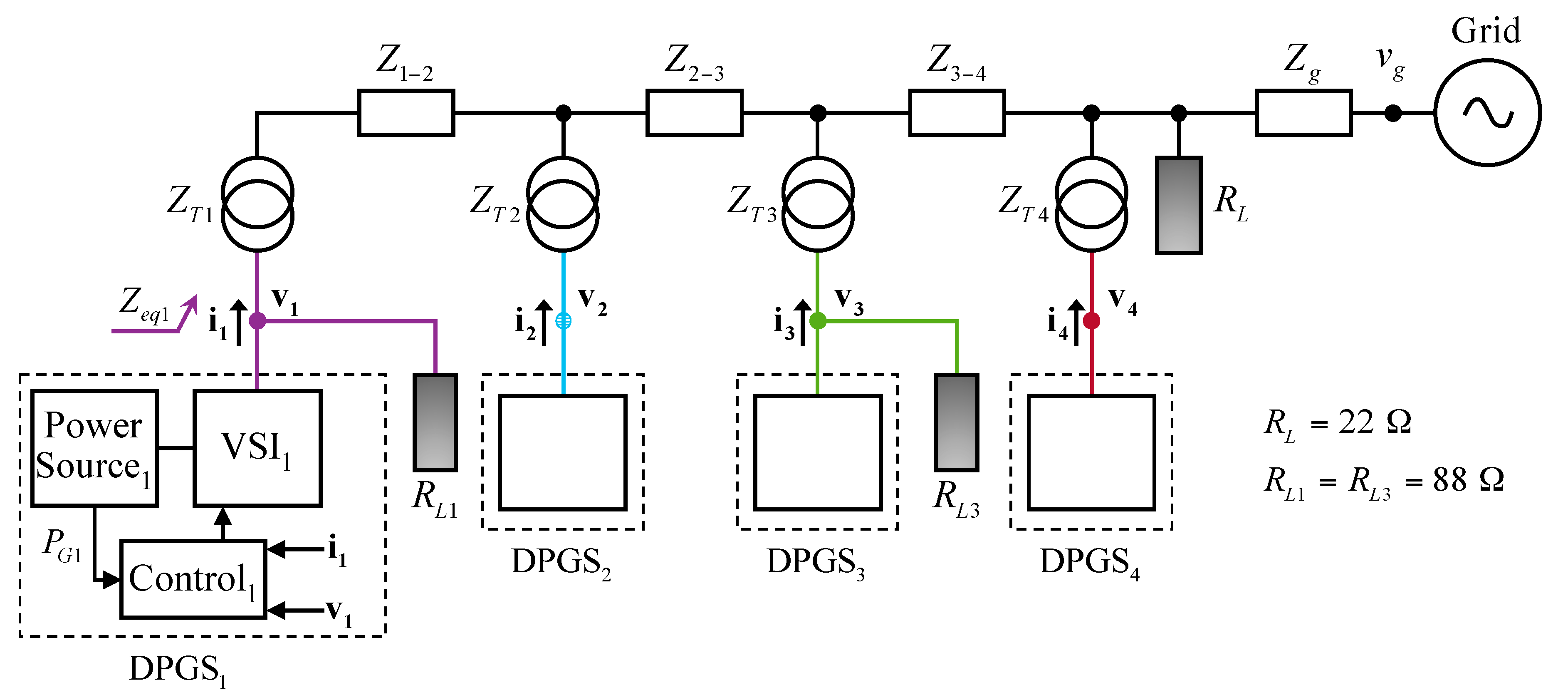
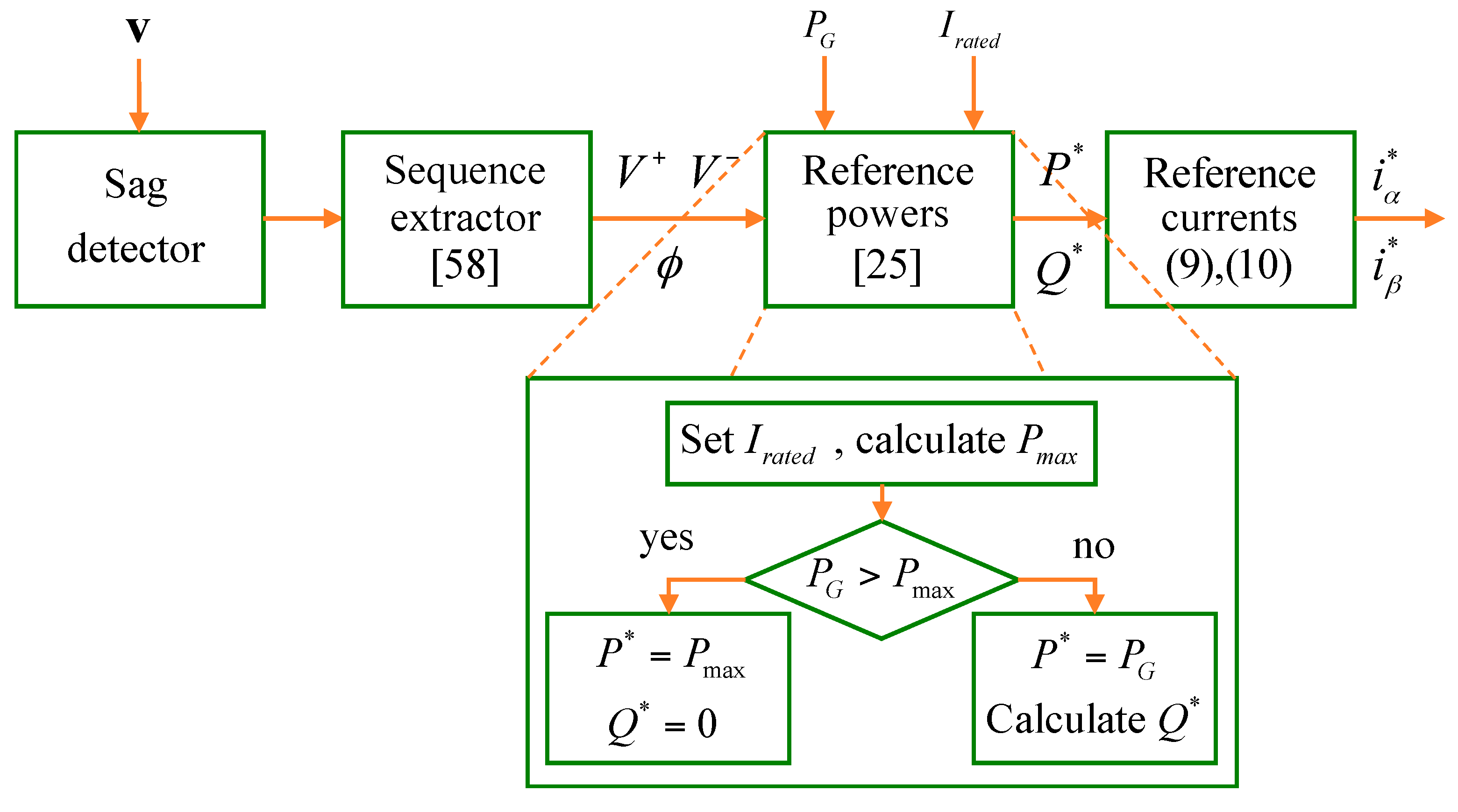
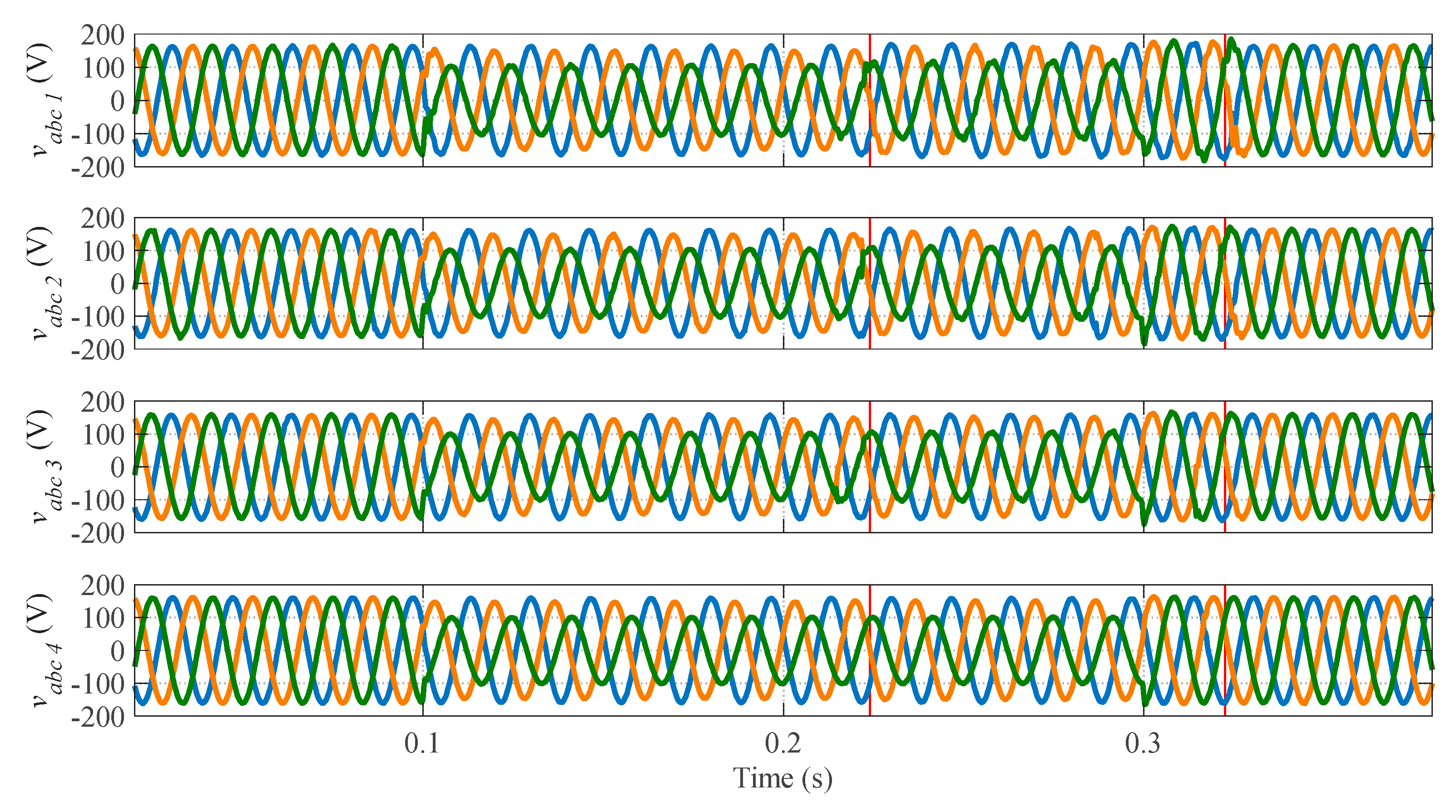
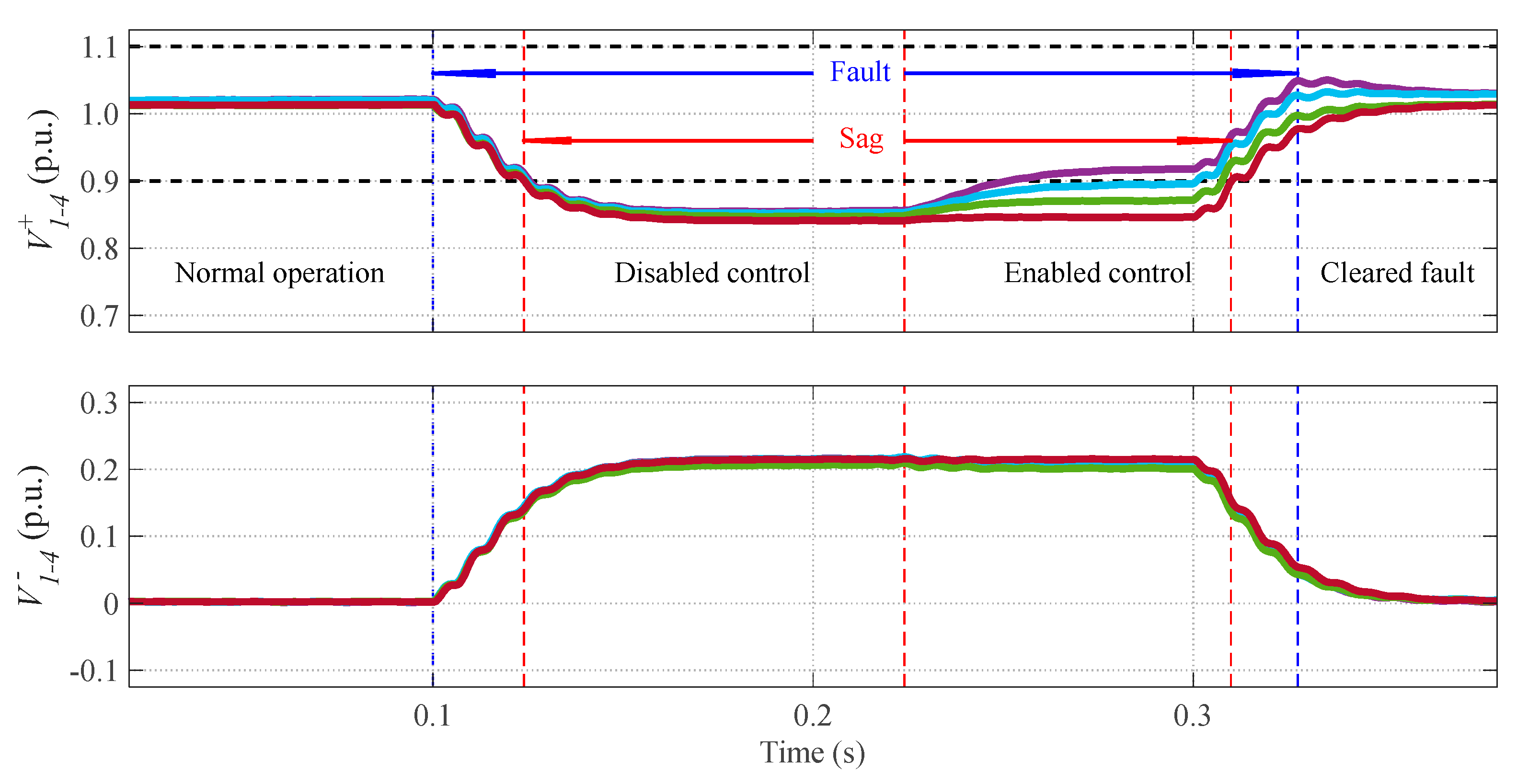


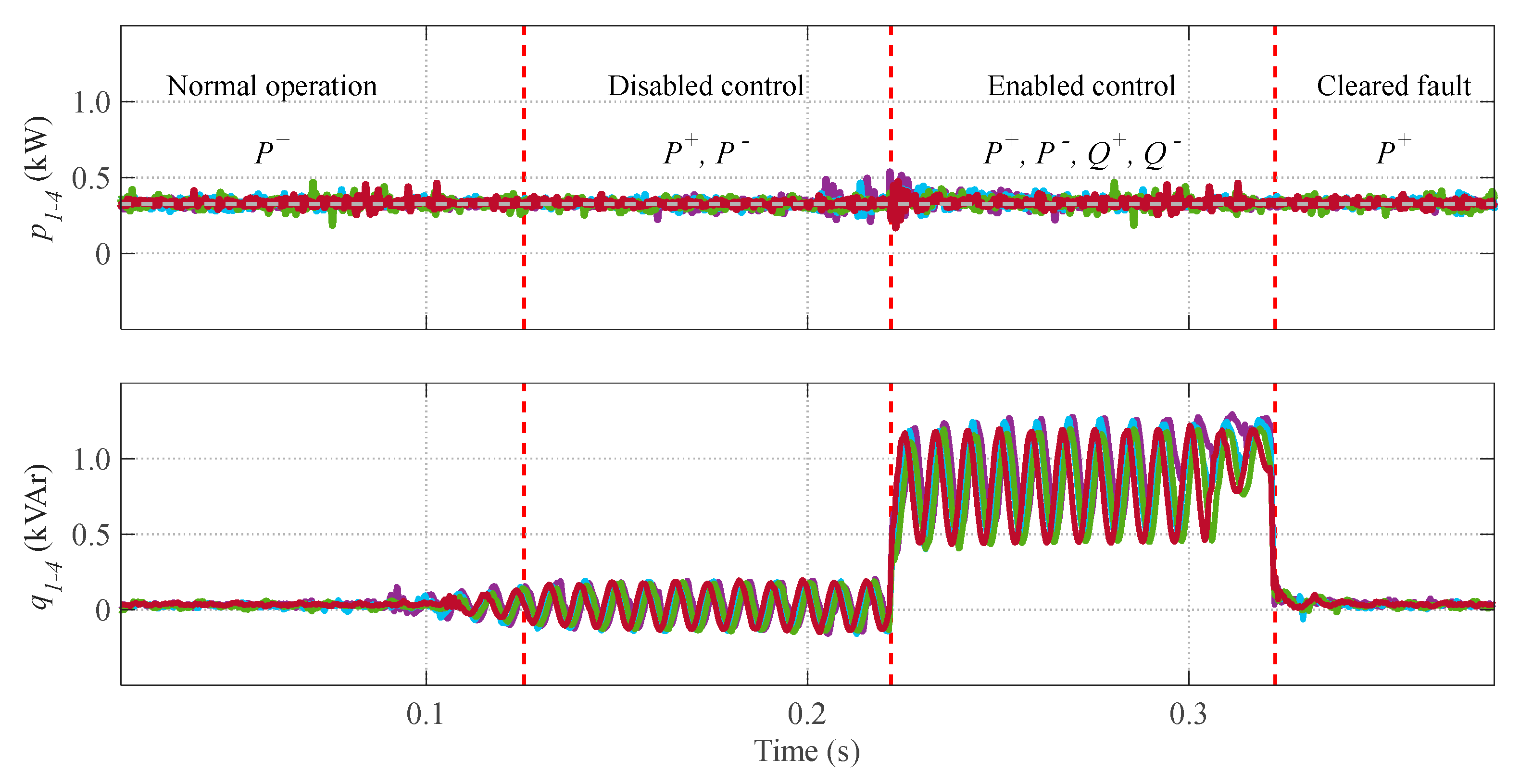





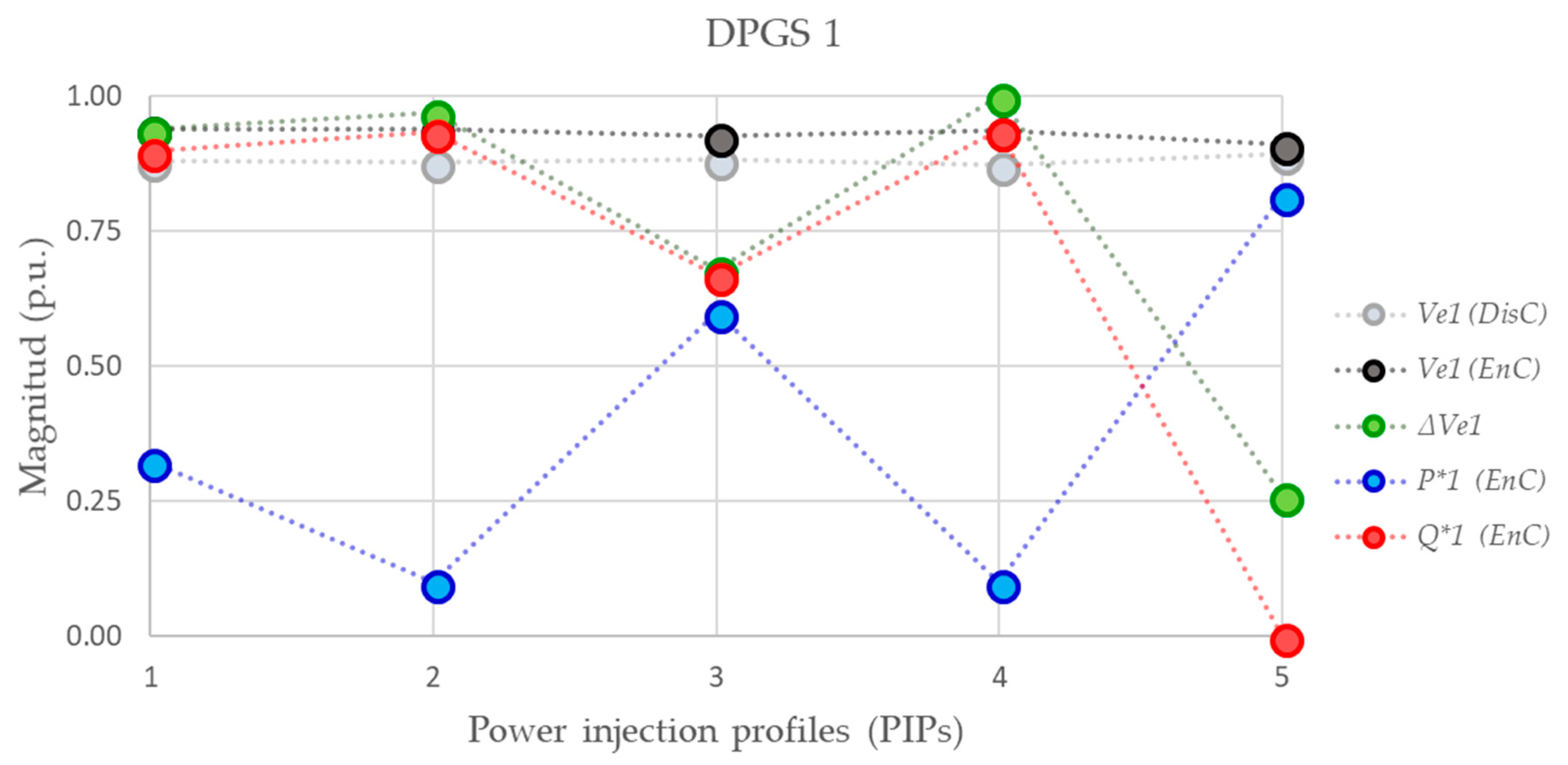
| Quantity | Acronym | Value |
|---|---|---|
| transformer equivalent inductances 1 and 2 | LT1,2 | 1.0 mH |
| transformer equivalent resistances 1 and 2 | RT1,2 | 0.5 Ω |
| transformer equivalent inductances 3 and 4 | LT3,4 | 0.6 mH |
| transformer equivalent resistances 3 and 4 | RT3,4 | 1.13 Ω |
| line inductance between 1 and 2 | L1–2 | 2.0 mH |
| line inductance between 2 and 3 | L2–3 | 0.8 mH |
| line inductance between 3 and 4 | L3–4 | 0.8 mH |
| DPGS | Req (Ω) | Leq (mH) | Zeq (Ω) | Angle θeq (deg.) | |Zeq| (Ω) |
|---|---|---|---|---|---|
| 1 | 0.50 | 4.60 | 0.50 + 1.73j | 73.92° | 1.80 |
| 2 | 0.50 | 2.60 | 0.50 + 0.98j | 62.97° | 1.10 |
| 3 | 1.13 | 1.40 | 1.13 + 0.53j | 25.04° | 1.25 |
| 4 | 1.13 | 0.60 | 1.13 + 0.23j | 11.32° | 1.15 |
| Strategy | Power Behavior | THD | Imax |
|---|---|---|---|
| IARC [39] | p̃ ≈ 0 and q̃ ≈ 0 negligible oscillations | high | high |
| AARC [39] | when Q = 0 ⇒ p̃ ≠ 0 when P = 0 ⇒ q̃ ≠ 0 | low | low |
| BPSC [39,55] | p̃ ≠ 0 and q̃ ≠ 0 lower oscillations | low | low |
| ICPS [55] | if Q ≠ 0 ⇒ p̃ ≠ 0 if P ≠ 0 ⇒ q̃ ≠ 0 | medium | high |
| PNSC [39,55] | when P ≠ 0 and Q = 0 ⇒ q̃ ≠ 0 when P = 0 and Q ≠ 0 ⇒ p̃ ≠ 0 | low | high |
| ZSCC [56] | p̃ = 0 and q̃ = 0 four-wire or six-wire systems | low | very high |
| FPNSC [39] | p̃ ≠ 0 and q̃ ≠ 0 power oscillations | low | properly controllable |
| FBSS (L grids) [16,25] | p̃ = 0 and q̃ ≠ 0 q̃ = 0 if P = 0 (special case) | low | properly controllable |
| FBSS (R grids) [57] | P ≠ 0, Q = 0, and q̃ ≠ 0 p̃ = 0 (special configuration) | low | properly controllable |
| VSS (RL grids) [52,53] | p̃ ≠ 0 and q̃ ≠ 0 | low | properly controllable |
| Quantity | Acronym | Value |
|---|---|---|
| grid voltage | V | 110.0 V rms |
| grid frequency | f | 60.0 Hz |
| rated power | Sb | 1.5 kVA |
| rated current | Irated | 5.0 A |
| LC filter inductances | Lf | 5.0 mH |
| LC filter capacitances | Cf | 1.5 µF |
| LC filter damping resistors | Rd | 68.0 Ω |
| Common resistive load | RL | 22.0 Ω |
| Local resistive loads | RL1, RL3 | 88.0 Ω |
| sampling/switching frequency | fs | 10.0 kHz |
| Power | DPGS | Profile 1 | Profile 2 | Profile 3 | Profile 4 | Profile 5 |
|---|---|---|---|---|---|---|
| PG (W) | 1 | 325.0 | 100.0 | 600.0 | 100.0 | 1000.0 |
| 2 | 325.0 | 300.0 | 300.0 | 100.0 | 100.0 | |
| 3 | 325.0 | 300.0 | 300.0 | 100.0 | 100.0 | |
| 4 | 325.0 | 600.0 | 100.0 | 1000.0 | 100.0 | |
| P* (W) | 1 | 325.0 | 100.0 | 600.0 | 100.0 | 817.8 |
| 2 | 325.0 | 300.0 | 300.0 | 100.0 | 100.0 | |
| 3 | 325.0 | 300.0 | 300.0 | 100.0 | 100.0 | |
| 4 | 325.0 | 600.0 | 100.0 | 780.9 | 100.0 | |
| Q* (VAr) | 1 | 898.0 | 935.3 | 669.5 | 937.2 | 0.0 |
| 2 | 848.8 | 842.7 | 846.7 | 903.0 | 881.3 | |
| 3 | 800.2 | 801.5 | 810.2 | 856.2 | 846.5 | |
| 4 | 786.6 | 541.7 | 851.7 | 0.0 | 841.7 |
© 2018 by the authors. Licensee MDPI, Basel, Switzerland. This article is an open access article distributed under the terms and conditions of the Creative Commons Attribution (CC BY) license (http://creativecommons.org/licenses/by/4.0/).
Share and Cite
Garnica, M.; García de Vicuña, L.; Miret, J.; Camacho, A.; Guzmán, R. Voltage Support Experimental Analysis of a Low-Voltage Ride-Through Strategy Applied to Grid-Connected Distributed Inverters. Energies 2018, 11, 1949. https://doi.org/10.3390/en11081949
Garnica M, García de Vicuña L, Miret J, Camacho A, Guzmán R. Voltage Support Experimental Analysis of a Low-Voltage Ride-Through Strategy Applied to Grid-Connected Distributed Inverters. Energies. 2018; 11(8):1949. https://doi.org/10.3390/en11081949
Chicago/Turabian StyleGarnica, Miguel, Luís García de Vicuña, Jaume Miret, Antonio Camacho, and Ramón Guzmán. 2018. "Voltage Support Experimental Analysis of a Low-Voltage Ride-Through Strategy Applied to Grid-Connected Distributed Inverters" Energies 11, no. 8: 1949. https://doi.org/10.3390/en11081949
APA StyleGarnica, M., García de Vicuña, L., Miret, J., Camacho, A., & Guzmán, R. (2018). Voltage Support Experimental Analysis of a Low-Voltage Ride-Through Strategy Applied to Grid-Connected Distributed Inverters. Energies, 11(8), 1949. https://doi.org/10.3390/en11081949






